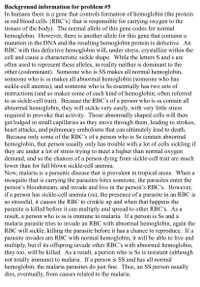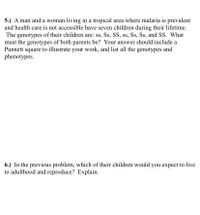
Human Anatomy & Physiology (11th Edition)
11th Edition
ISBN: 9780134580999
Author: Elaine N. Marieb, Katja N. Hoehn
Publisher: PEARSON
expand_more
expand_more
format_list_bulleted
Question
Question 6 please

Transcribed Image Text:Background information for problem #5
In humans there is a gene that controls formation of hemoglobin (the protein
in red blood cells {RBC's} that is responsible for carrying oxygen to the
tissues of the body). The normal allele of this gene codes for normal
hemoglobin. However, there is another allele for this gene that contains a
mutation in the DNA and the resulting hemoglobin protein is defective. An
RBC with this defective hemoglobin will, under stress, crystallize within the
cell and cause a characteristic sickle shape. While the letters S and s are
often used to represent these alleles, in reality neither is dominant to the
other (codominant). Someone who is SS makes all normal hemoglobin,
someone who is ss makes all abnormal hemoglobin (someone who has
sickle-cell anemia), and someone who is Ss essentially has two sets of
instructions (and so makes some of each kind of hemoglobin; often referred
to as sickle-cell trait). Because the RBC's of a person who is ss contain all
abnormal hemoglobin, they will sickle very easily, with very little stress
required to provoke that activity. Those abnormally shaped cells will then
get lodged in small capillaries as they move through them, leading to strokes,
heart attacks, and pulmonary embolisms that can ultimately lead to death.
Because only some of the RBC's of a person who is Ss contain abnormal
hemoglobin, that person usually only has trouble with a lot of cells sickling if
they are under a lot of stress trying to meet a higher than normal oxygen
demand, and so the chances of a person dying from sickle-cell trait are much
lower than for full blown sickle-cell anemia.
Now, malaria is a parasitic disease that is prevalent in tropical areas. When a
mosquito that is carrying the parasites bites someone, the parasites enter the
person's bloodstream, and invade and live in the person's RBC's. However,
if a person has sickle-cell anemia (ss), the presence of a parasite in an RBC is
so stressful, it causes the RBC to crinkle up and when that happens the
parasite is killed before it can multiply and spread to other RBC's. As a
result, a person who is ss is immune to malaria. If a person is Ss and a
malaria parasite tries to invade an RBC with abnormal hemoglobin, again the
RBC will sickle, killing the parasite before it has a chance to reproduce. If a
parasite invades am RBC with normal hemoglobin, it will be able to live and
multiply, but if its offspring invade other RBC's with abnormal hemoglobin,
they too, will be killed. As a result, a person who is Ss is resistant (although
not totally immune) to malaria. If a person is SS and has all normal
hemoglobin, the malaria parasites do just fine. Thus, an SS person usually
dies, eventually, from causes related to the malaria.

Transcribed Image Text:5.) A man and a woman living in a tropical area where malaria is prevalent
and health care is not accessible have seven children during their lifetime.
The genotypes of their children are: ss, Ss, SS, ss, Ss, Ss, and SS. What
must the genotypes of both parents be? Your answer should include a
Punnett square to illustrate your work, and list all the genotypes and
phenotypes.
6.) In the previous problem, which of their children would you expect to live
to adulthood and reproduce? Explain.
Expert Solution
This question has been solved!
Explore an expertly crafted, step-by-step solution for a thorough understanding of key concepts.
This is a popular solution
Trending nowThis is a popular solution!
Step by stepSolved in 2 steps

Knowledge Booster
Learn more about
Need a deep-dive on the concept behind this application? Look no further. Learn more about this topic, biology and related others by exploring similar questions and additional content below.Similar questions
- QUESTION 17 Increased sympathetic stimulation will increase the pacemaker potential in the heart decrease the rate and depth of breathing constrict the smooth muscle of the iris of the eye increase digestion in the gastrointestinal tractarrow_forwardwhy 7arrow_forwardCan you answer question 6 pleasearrow_forward
- QUESTION 42 Organization of Skeletal Muscle 3 Tendons connect to a. bones, bones b. ligaments, bones c. muscle, bones d. muscle, ligaments SOO000arrow_forwardQUESTION 8 Oxygen-rich blood is found in the pulmonary veins O inferior vena cava O right ventricle systemic venulesarrow_forwardWhat would the answers to each of the questions be?arrow_forward
- QUESTION 33 In the image below, the greater guentum is indicated by letter A D B Carrow_forwardQuestion 52 In women, laparoscopy would be used to diagnose and /or remove all but O Fibroids O cervical polyps ovarian cysts adhesions lages may not show up) - use Chr << Previous Nearrow_forwardMitochondrial toxicity drugsarrow_forward
arrow_back_ios
SEE MORE QUESTIONS
arrow_forward_ios
Recommended textbooks for you
 Human Anatomy & Physiology (11th Edition)BiologyISBN:9780134580999Author:Elaine N. Marieb, Katja N. HoehnPublisher:PEARSON
Human Anatomy & Physiology (11th Edition)BiologyISBN:9780134580999Author:Elaine N. Marieb, Katja N. HoehnPublisher:PEARSON Biology 2eBiologyISBN:9781947172517Author:Matthew Douglas, Jung Choi, Mary Ann ClarkPublisher:OpenStax
Biology 2eBiologyISBN:9781947172517Author:Matthew Douglas, Jung Choi, Mary Ann ClarkPublisher:OpenStax Anatomy & PhysiologyBiologyISBN:9781259398629Author:McKinley, Michael P., O'loughlin, Valerie Dean, Bidle, Theresa StouterPublisher:Mcgraw Hill Education,
Anatomy & PhysiologyBiologyISBN:9781259398629Author:McKinley, Michael P., O'loughlin, Valerie Dean, Bidle, Theresa StouterPublisher:Mcgraw Hill Education, Molecular Biology of the Cell (Sixth Edition)BiologyISBN:9780815344322Author:Bruce Alberts, Alexander D. Johnson, Julian Lewis, David Morgan, Martin Raff, Keith Roberts, Peter WalterPublisher:W. W. Norton & Company
Molecular Biology of the Cell (Sixth Edition)BiologyISBN:9780815344322Author:Bruce Alberts, Alexander D. Johnson, Julian Lewis, David Morgan, Martin Raff, Keith Roberts, Peter WalterPublisher:W. W. Norton & Company Laboratory Manual For Human Anatomy & PhysiologyBiologyISBN:9781260159363Author:Martin, Terry R., Prentice-craver, CynthiaPublisher:McGraw-Hill Publishing Co.
Laboratory Manual For Human Anatomy & PhysiologyBiologyISBN:9781260159363Author:Martin, Terry R., Prentice-craver, CynthiaPublisher:McGraw-Hill Publishing Co. Inquiry Into Life (16th Edition)BiologyISBN:9781260231700Author:Sylvia S. Mader, Michael WindelspechtPublisher:McGraw Hill Education
Inquiry Into Life (16th Edition)BiologyISBN:9781260231700Author:Sylvia S. Mader, Michael WindelspechtPublisher:McGraw Hill Education

Human Anatomy & Physiology (11th Edition)
Biology
ISBN:9780134580999
Author:Elaine N. Marieb, Katja N. Hoehn
Publisher:PEARSON

Biology 2e
Biology
ISBN:9781947172517
Author:Matthew Douglas, Jung Choi, Mary Ann Clark
Publisher:OpenStax

Anatomy & Physiology
Biology
ISBN:9781259398629
Author:McKinley, Michael P., O'loughlin, Valerie Dean, Bidle, Theresa Stouter
Publisher:Mcgraw Hill Education,

Molecular Biology of the Cell (Sixth Edition)
Biology
ISBN:9780815344322
Author:Bruce Alberts, Alexander D. Johnson, Julian Lewis, David Morgan, Martin Raff, Keith Roberts, Peter Walter
Publisher:W. W. Norton & Company

Laboratory Manual For Human Anatomy & Physiology
Biology
ISBN:9781260159363
Author:Martin, Terry R., Prentice-craver, Cynthia
Publisher:McGraw-Hill Publishing Co.

Inquiry Into Life (16th Edition)
Biology
ISBN:9781260231700
Author:Sylvia S. Mader, Michael Windelspecht
Publisher:McGraw Hill Education